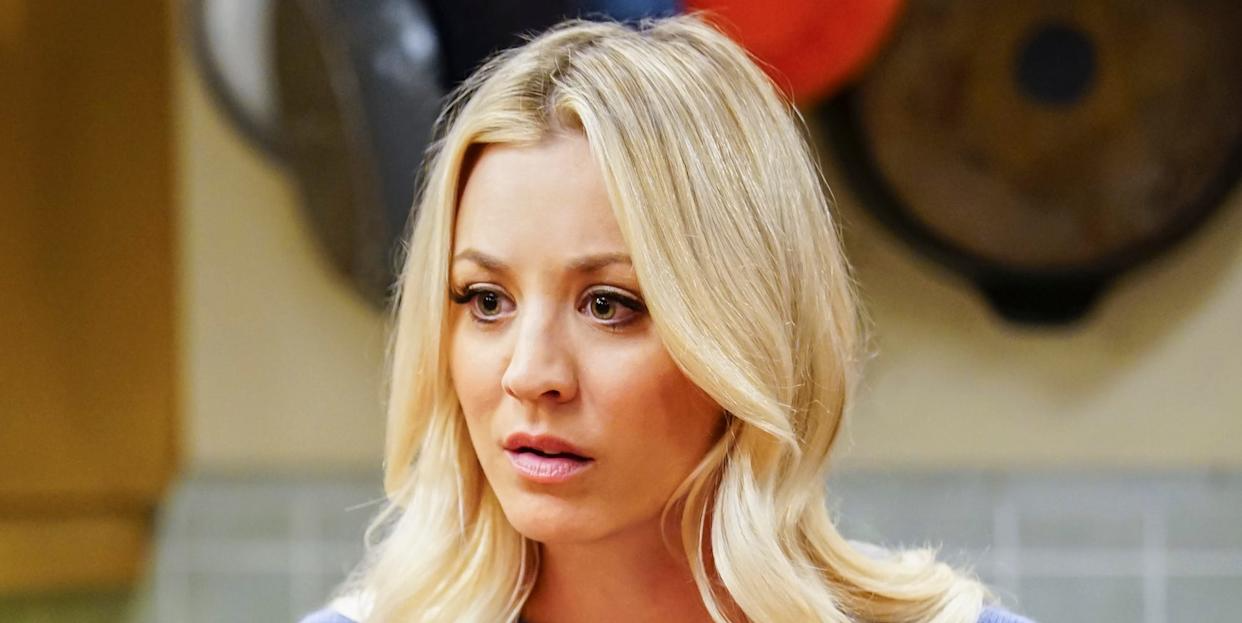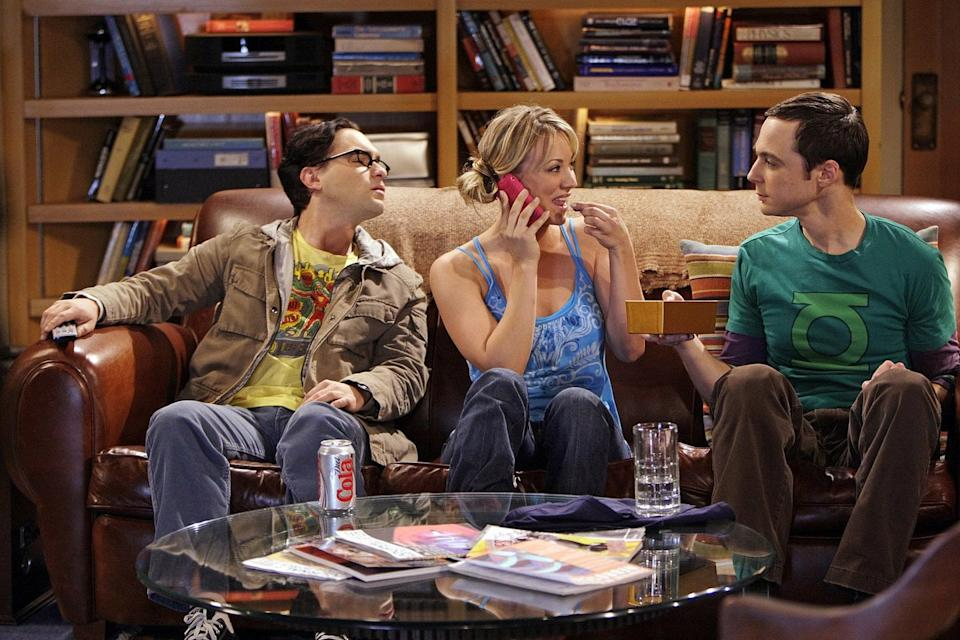
For years, fans of The Big Bang Theory knew Penny as the quintessential “girl next door” with her blonde hair, charming smile, and “not-so-book-smart” persona. However, what many may not realize is that behind the scenes, the show’s creators worked hard to evolve Penny’s character, making her more nuanced, complex, and, frankly, less of a cliché. Kaley Cuoco, who played Penny, became one of the standout characters on the show, but it wasn’t always clear that Penny would grow beyond the trope of being “the pretty but naïve waitress.”
Big Bang Theory boss Chuck Lorre recently admitted that it “took a while” to move Penny away from being perceived as “clichéd,” and this transformation became one of the most notable aspects of her character development. This article dives into why Penny was initially portrayed in a certain way and how the show’s team worked to reshape her into a more authentic, well-rounded character.
1. The ‘Clichéd’ Beginning: Penny’s Early Days on Big Bang Theory
The Stereotypical Starting Point
When The Big Bang Theory premiered in 2007, Penny (Kaley Cuoco) entered as the “girl next door” archetype—a waitress living next door to two quirky scientists, Sheldon Cooper and Leonard Hofstadter. At first, Penny’s role was easy to define: the beautiful, socially savvy woman surrounded by the nerdy, somewhat socially inept men. Her character was often portrayed as somewhat of a stereotype—a trope that the audience was familiar with but didn’t necessarily see as groundbreaking.
Why Was Penny So Cliché?
The show’s early seasons leaned heavily into Penny’s role as the object of affection for Leonard and the other male characters. She was portrayed as the “relatable, pretty girl” who found herself in awkward situations due to her lack of academic knowledge and her contrast to the intellectual world of her neighbors. While Penny was charming, her role as the “dumb blonde” was a tired stereotype that seemed to define her character.
2. The Turning Point: Penny’s Transformation Begins
The Shift in Focus: Penny’s Personal Growth
As The Big Bang Theory progressed, the creators noticed a need for change. Chuck Lorre himself admitted that Penny’s evolution was necessary because she had started to feel a bit “one-dimensional.” As the show’s creators worked to break free from the stereotypical mold, Penny began to transform into a more dynamic and multi-dimensional character.
One of the key moments of this transformation came when Penny went back to school and pursued a career in pharmaceutical sales. No longer just a waitress, Penny’s career choice showed that she was ambitious, smart, and capable of much more than the “airhead” persona she initially carried. This was one of the first steps in moving her away from being just a stereotype.
Building Depth: Penny’s Relationships with the Guys
Another important aspect of Penny’s evolution was her relationship with the male characters, especially Sheldon and Leonard. Early on, Penny was primarily involved in a love triangle between Leonard and Sheldon, but over time, her friendships with them grew into more meaningful dynamics. As the show progressed, Penny became more than just the guys’ love interest. She was a confidante, a source of wisdom, and even the one to call out Sheldon’s absurd behaviors, making her feel more like an integral part of the team.

3. Kaley Cuoco’s Personal Growth and Influence on Penny
Kaley Cuoco’s Growing Influence
Kaley Cuoco’s own growth as an actress played a huge role in how Penny was portrayed on screen. Over the course of 12 seasons, Cuoco’s talent expanded beyond the simple comedic roles she initially played. As her character deepened, Cuoco brought a more refined and nuanced performance, allowing Penny to transition into someone who was confident, smart, and independent—traits that helped elevate the character beyond her initial trope.
Emotional Range and Vulnerability
One of the most significant changes in Penny’s character was her emotional evolution. She was no longer just the comic relief or the love interest. Instead, Penny became a character with emotional depth—dealing with issues like her difficult relationship with her family, her insecurities about her career, and her struggle with commitment in her relationship with Leonard. These storylines made Penny feel more real, showcasing a side of her that wasn’t just defined by her looks or social status.
4. Penny’s Love Story with Leonard: From Cliché to Complicated
The Start of Leonard and Penny’s Relationship
Leonard and Penny’s relationship was initially filled with classic “will-they-won’t-they” tension. Leonard, who was deeply in love with Penny from the start, was often portrayed as the awkward, socially anxious guy who couldn’t quite figure out how to win her over. Penny, on the other hand, struggled with her feelings for Leonard, often seeing him as just a nerdy, good guy.
However, as the show developed, so did their relationship. The writers explored their deep emotional connection rather than just relying on the cliché of Penny choosing between nerdy Leonard and a more typical “bad boy.” Their ups and downs, as well as the complexity of their bond, eventually made their relationship one of the most beloved on television.
Penny’s Growing Commitment to Leonard
As Penny evolved, her relationship with Leonard became more serious and grounded. Their relationship no longer felt like a clichéd pairing, and instead, it became one of mutual respect and support. Penny no longer needed to be the “love interest” but rather a partner in every sense of the word, evolving from the stereotype to a deeply layered character.
5. Breaking Stereotypes: Penny Becomes More Than Just a Pretty Face
Penny as a Career Woman
Another important aspect of Penny’s evolution was her career progression. Initially, she was portrayed as a waitress, and while this was part of her charm, it also pigeonholed her character. As the series went on, Penny’s ambitions shifted. Her successful career in pharmaceutical sales allowed her to grow as a professional, showcasing that she wasn’t just the stereotypical “dumb blonde.” This career shift also made her relationship with Leonard more relatable, as they both faced challenges in balancing their personal and professional lives.
Penny’s Relationship with Her Family
Penny’s family dynamics were another avenue that helped break her “clichéd” mold. Early on, Penny’s relationship with her family was strained, with her dysfunctional background providing ample material for humor. However, as the series progressed, Penny’s relationship with her family became more complex and realistic, showing her growth as an individual who could still love her family while navigating her own independence.
6. Chuck Lorre’s Vision for Penny
Why It Took Time to Develop Penny
Chuck Lorre, the show’s creator, has often spoken about how Penny’s character needed to evolve in a way that felt authentic and not rushed. The character’s depth couldn’t be forced—Penny’s transformation had to be gradual and earned. Lorre has stated that it “took a while” for the team to make Penny feel less “clichéd,” but it was well worth the wait.
This careful character development helped Penny become one of the most beloved characters on television, allowing her to shine through as more than just a stereotype.
Conclusion: Penny’s Evolution and Why It Matters
Kaley Cuoco’s portrayal of Penny in The Big Bang Theory is a testament to the power of thoughtful character development. What started as a simple archetype evolved into a character filled with depth, vulnerability, and strength. Penny’s transformation from a clichéd, stereotypical figure to a complex, relatable character is one of the show’s most significant achievements.
Through Penny, fans saw how someone can grow, change, and overcome personal obstacles, all while remaining true to themselves. Her evolution made her more than just the “pretty girl” next door—she became a strong, independent, and multifaceted woman who resonated with audiences on a much deeper level.
FAQs
-
Why was Penny initially portrayed as a stereotypical character? Penny was originally written as the “girl next door” archetype to contrast with the nerdy scientists, creating comedic situations early on in the show.
-
How did Penny’s character evolve throughout the show? Penny’s character evolved by pursuing a career in pharmaceutical sales, developing a deeper emotional connection with the other characters, and overcoming her personal insecurities.
-
What role did Kaley Cuoco play in shaping Penny’s evolution? Kaley Cuoco’s growth as an actress allowed her to bring more emotional depth to Penny, helping move her beyond the initial stereotype.
-
How did Penny’s relationship with Leonard change over time? Penny and Leonard’s relationship grew from a clichéd love story into a mature partnership based on mutual respect and emotional support.
-
Why is Penny’s character so beloved by fans? Fans love Penny because she is relatable, flawed, and resilient. Her evolution into a more complex character made her a favorite for many viewers.
